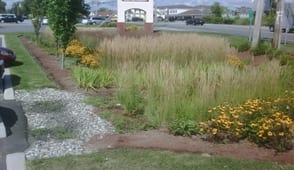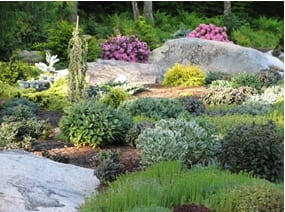by Geoffrey Kuter, Ph.D.
Composts are highly versatile and valuable products with multiple uses in sustainable landscaping. When using composts made from waste materials, carbon and nutrients are recycled to the soil and the generation of methane, a potent greenhouse gas and by product from landfill disposal, is reduced.
Adding compost to the soil can simultaneously adjust soil pH, increase the nutrient levels in the soil and the ability of the soil to store nutrients (e.g. cation exchange capacity), improve soil structure, and enhance populations of beneficial microorganisms.
Match the Compost to the Site and Goals
Not all composts are the same and composts will vary depending upon the sources of the inputs. For example, in New England composts prepared from leaves are very commonly available and are excellent sources of organic matter. However, leaf composts typically have lower levels of nutrients and organic matter than composts that are made from biosolids or animal manures. Biosolids, the solids generated from the treatment of wastewater are typically composted with wood chips or sawdust and the resulting compost is lighter in bulk weight and has higher levels of not only organic matter but also macro and micro-nutrients. Spent mushroom composts, commonly available in Pennsylvania, will contribute not only nutrients but have generally higher levels of soluble salts and thus may not be usable at the same rates in certain applications. The level of soluble salts, measured as electrical conductivity, is particularly critical when composts are used in potting media where plants are growing in a confined environment.
Successful use of composts in sustainable landscaping requires understanding not only the goals and objectives of the landscape project, but also the existing soil and environmental site conditions and how the qualities and characteristics of the various composts will enhance the soil. Soil requirements for a perennial flower bed are very different from those for a sports field that will be subject to heavy traffic or for a rain garden that must handle large volumes of water running off a parking lot. Soil conditions can vary considerably from site to site and need to be adjusted to match the specific landscape function.
In the majority of landscape projects, compost are simply applied as soil amendments and are used to raise the organic matter content up to generally recommended levels. In the Northeast, levels of organic matter in soils are often lower than optimal and the addition of composts is a safe and easy way to effectively add to soil organic matter levels.
The myriad benefits of soil organic matter are well documented and almost all soils will benefit from addition of composts. In many cases just adding 20 to 25 % compost by volume (e.g. one to two inches of compost tilled into the top four to six inches of the soil) will be adequate to bring soil organic matter levels up to prescribed beneficial levels (see Table 1). By increasing soil organic matter sustainable landscaping goals of reducing uses of fertilizers, improving water infiltration, and minimizing use of irrigation water can be realized.
Table 1: Raising Soil Organic Matter Percentages
| Percentage to Raise | Compost Inclusion Rate (by volume) | |
| 1% | 8% | |
| 2% | 15% | |
| 3% | 22% | |
| 4% | 27% | |
| 5% | 32% | |
| 6% | 37% | |
| 7% | 41% | |
| 8% | 44% | |
| 9% | 47% | |
| 10% | 50% |
Although all composts will provide organic matter they also will contribute fine silt and clay particles. These fine particles can reduce the flow of water through the soil especially when that soil is subject to compaction through foot traffic. Thus when compost is used in the construction of golf green or sports field, it should be evaluated for impact on drainage. Similarly when building rain gardens or other structures (e.g. infiltration basins) designed to handle storm water runoff, care must be taken to have the proper soil structure so that water can rapidly infiltrate through the soil.

Custom soil mix prepared with sand and compost is designed to provide rapid infiltration of storm water draining from a parking lot into a rain garden.
Adjusting for Nutrients
Different sources of composts will also add different amounts of nutrients. For example, composts made with biosolids or manures will contain significant amounts of both nitrogen and phosphorus than compost made solely from leaf and yard wastes. When used at high rates (e.g. more than 25% by volume) levels of nutrients can exceed recommended levels. Soils that have been amended repeatedly with either chicken or cow manure (whether composted or not) can often have levels of phosphorus that exceed the needs for plant growth, in which case soil testing should be performed to assure that nutrient levels adjusted properly.
Knowledge about the specific qualities and characteristics of compost can be obtained from the supplier and the compost supplier should be expected to provide results of testing by qualified laboratories and guidance on the use of the product. Be cautious with regard to claims that particular compost has unique microbial populations that will enhance plant growth or reduce the likelihood of disease. The primary befits of using compost are the nutritional and structural changes it provides to soil. For example, using compost to reduce soil compaction will result in better rooting depth and better root mass. These are critical benefits that can be achieved by proper applications of almost all composts and can have long lasting effects that will outlast the addition of microbes that will not likely survive in the highly competitive soil environment.
Benefits of Compost Mulch
In addition to using compost as a soil amendment, compost can be excellent mulches. Much of the mulch that is available is largely wood that is mixed with small amounts of bark or is colored. The wood in contact with the soil will naturally decompose and the active microorganisms will utilize the nutrients in the soil and they will not be available for the plant roots that are near the soil surface. As a consequence plant growth can be inhibited. In contrast when compost is added to the soil surface and begins to continue the decomposition process, nutrients will be released and can be taken up by the plants. Over time the compost will build up the soil organic matter from the top down.
In conclusion, match the characteristics of the compost to the goals and objectives of the project. Building a planting bed or planting trees and shrubs requires different soil than when constructing a golf green, athletic field, or a wetland. In addition, the rate of application should be adjusted in conformance with soil test results and plant growth needs. However for most simple landscaping projects there are numerous benefits that are obtained by using compost that can be realized when following standard recommended application rates.
About the Author
Dr. Geoffrey Kuter has a degree in Botany and Plant Pathology from the University of Wisconsin-Madison and is President of Agresource, Inc., a Massachusetts based company that operates composting facilities handling municipal biosolids, leaf and yard wastes, and food residuals. Agresource markets compost for various composting facilities in the northeast and distributes in excess of 100,000 cubic yards of compost annually from more than 12 facilities from Maine to Maryland. Dr. Kuter may be reached at gkuter@Agresourceinc.com or by phone at 978-388-5110.


